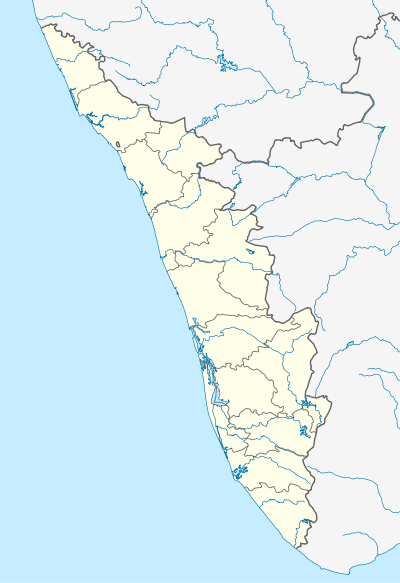Tirunavaya Temple
| Thirunavaya Temple | |
|---|---|
|
Tirunavaya Nava Mukunda Temple | |
 Thirunavaya Temple Location in Kerala state, India | |
| Name | |
| Proper name | Tirunavaya Nava Mukunda Temple |
| Geography | |
| Coordinates | 10°51′50″N 75°58′56″E / 10.86389°N 75.98222°ECoordinates: 10°51′50″N 75°58′56″E / 10.86389°N 75.98222°E |
| Country | India |
| State | Kerala |
| District | Mallapuram |
| Location | Tirunavaya, Kerala |
| Culture | |
| Primary deity | Nava Mukundan (Vishnu) |
| Consort | Malarmangai NachiyarLakshmi |
| Temple tank | Sengamala Saras |
| Shrine | Veta Vimanam |
| Architecture | |
| Architectural styles | Kerala Temple Architecture |
Tirunavaya Temple is a historically significant ancient Hindu temple on the banks of the Bharathapuzha River dedicated to Nava Mukundan (Vishnu) with the other deities like Ganesha, and Lakshmi.[1] It is located near the ancient Hindu pilgrimage centre of Tirunavaya, a village 8 km south of Tirur in the Malappuram district of Kerala state, India. The temple was the traditional venue for the historic ritual of the Mamankam festival, an enactment of traditional martial arts by suicide squads.The temple was attacked first during Tipu Sultan's invasion in 18th century and later in 1921 during the Moplah rebellion.[2] It also figures among the 106 Divya Desams that exist in the Earthly realm according to the Tamil Alvar tradition of the 9th Century.[3]
Legends associated with Tirunavaya Temple
According to the local legends, goddess Lakshmi and Gajendra, the king of the elephants, worshiped god Vishnu here with lotus flowers from a lake nearby; with the two devotees using flowers from the same source, its supply dwindled, and Gajendra appealed to Vishnu, who took Lakshmi by his side on the same throne and accepted worship offered by Gajendra.[4]
There is another legend associated with the Tirunavaya Temple. The deity is called "Nava Mukundan" as it is believed that the idol was the ninth one to be installed in the shrine by a group of Hindu saints known as "Navayogis". The first eight idols disappeared as soon as they were placed there and the ninth sank to its knees before it was forcibly stopped.[5] It was originally called Navayogisthala and which later became Thirunavya.[6] It is interesting that the image of Nava Mukundan is portrayed only from above the knee, the rest of the image being concealed within the ground. There is believed to be a bottomless unexplored pit behind the image in the sanctum.[4]
See also
References
- ↑ "Thirunavaya Temple". Indian Temples Portal. Retrieved 13 October 2006.
- ↑ "Malappuram Tourist Attraction - Pilgrimage Centres". Mallapuram District administration. Retrieved 13 October 2006.
- ↑ "Thirnavaya temple". Chennai Live News. 13 October 2006. Retrieved 28 November 2016.
- 1 2 "Thirunavaya temple". Templenet. Retrieved 28 November 2016.
- ↑ "Destination Thirunavaya". Outlook. 2006. Retrieved 28 November 2016.
- ↑ R., Dr. Vijayalakshmy (2001). An introduction to religion and Philosophy - Tévarám and Tivviyappirapantam (1st ed.). Chennai: International Institute of Tamil Studies. pp. 513–4.